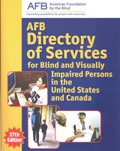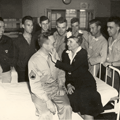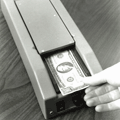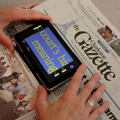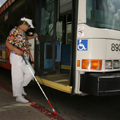1921: The American Foundation for the Blind (AFB) was founded by a group of educators and leaders in the burgeoning field of rehabilitation for blind people, with the support of M.C. Migel, a philanthropist who wanted to help the large number of veterans blinded in World War I. AFB began its mission to:
- provide a national clearinghouse for information about vision loss
- create a forum for blindness service professionals
- generate new directions for research
- represent the needs of people with vision loss in the creation of public policy
1924-1968: Helen Keller—the world-famous author, activist, and advocate—helped to raise AFB's profile when she began working with the organization in 1924. Helen Keller worked for AFB for 44 years and changed the world's perception of being blind and deaf. In addition to serving as AFB's counselor on national and international relations, she made countless speeches and appearances at home and in more than 39 countries worldwide on behalf of the organization. She lobbied extensively for the creation of State Commissions for the Blind, the construction of schools for those with vision loss, and the government to print and distribute books in braille for use across the United States.
1928: AFB distributed radios to citizens who are blind, giving them firsthand access to breaking news. This was the Foundation's first direct service to blind individuals.
1929: AFB created a nationwide Directory of Services for people with vision loss. Now available online, the Directory remains an indispensable resource.
1932: AFB developed Talking Books and Talking Book machines. These long-playing records played on special machines, opened the door of knowledge and transformed the lives of thousands of Americans nationwide. AFB later successfully advocated for distributing talking books by the National Library Service for the Blind. AFB was instrumental in the passage of a law to establish the NLS.
1938: AFB played the leading role in the passage of the Wagner O'Day Act, which radically improved employment opportunities for people with vision loss. This law required the federal purchase of blind-made products.
1945: Following World War II, the Veterans Administration asked AFB to help set up its rehabilitation program for blinded soldiers. M. C. Migel, AFB's President and CEO, gave what was at that time a large donation of $10,000 towards establishing the Blinded Veterans Association.
1966: AFB improved the education of blind and visually impaired children by helping to develop nationwide standards. AFB established the National Accreditation Council (NAC) to ensure uniform educational services and standardized teaching practices for children with visual impairments by developing educational standards and curricula that agencies and schools could follow nationwide.
1975: AFB played a major role in passing legislation to ensure that children with vision loss are mainstreamed into America's public education system. Until this time, over 90% of blind and visually impaired students were taught in residential schools. This legislation, known as IDEA, ultimately resulted in the creation of comprehensive curriculum guidelines for public school programs serving visually impaired children.
1980: Two years of study and discussion on the needs of parents of visually impaired children culminated in establishing the National Association of Parents of the Visually Impaired, the first national organization for parents of children who are blind or visually impaired. Together, the two organizations later created FamilyConnect.
1983: AFB began marketing a talking device identifying U.S. paper currency.
1990: AFB was instrumental in the passage of the Americans with Disabilities Act. This landmark civil rights law gave Americans with disabilities more public access and greater protections against discrimination.
1990s: AFB successfully rallied educators, parents, and professionals to keep braille in the school systems.
1991: Access Awards, which honor individuals, corporations, and organizations that are eliminating or substantially reducing inequities faced by people who are blind or visually impaired, established.
2000: AccessWorld, AFB’s technology magazine first published.
2002: AFB opens AFB TECH in Huntington, WV. AFB TECH worked with companies to make medical devices, household appliances, office equipment, and communications technology accessible to people with vision loss.
2002: AFB fought to ensure that people with vision loss can vote independently and privately. Great progress was made with the passage of the Help America Vote Act.
2003: AFB Consulting was founded to help organizations and partners advance their accessibility and inclusion goals.
2004: AFB led the advocacy effort to ensure children with visual impairments receive their textbooks and classroom materials on time and in braille, large print, and electronic formats. The National Instructional Materials Access Center (NIMAC) was established to facilitate access to electronic versions of textbooks for students in grades K-12.
2006: AFB opened its Center on Vision Loss in Dallas, Texas to help provide information to older Americans with low vision. Its centerpiece is Esther's Place, a fully furnished model home with simple adaptations and products designed to make daily life more manageable for individuals with vision loss.
2007: Corinne Kirchner Research Award, which honors the best minds in the field of visual impairment, established.
2007: AFB launched Senior Site® to provide aging adults, their families, and caregivers with practical advice and help on living independently and productively with vision loss. In 2012, to better respond to the information and rehabilitation needs of the increasing numbers of adults with vision loss, the American Foundation for the Blind and Reader’s Digest Partners for Sight Foundation joined forces to integrate Senior Site and VisionAware into a single website, visionaware.org.
2008: The American Foundation for the Blind and the National Association for Parents of Children with Visual Impairments (NAPVI) launched FamilyConnect, an online community for parents and guardians of children with visual impairments. The American Printing House now stewards FamilyConnect.org for the Blind.
2010: AFB led the way for the passage of the 21st Century Communications and Video Accessibility Act. This landmark law requires television programs, smartphones, and other modern communications technologies to be accessible.
2014: Stephen Garff Marriott Award was established to honor a blind or visually impaired individual who has served as an extraordinary mentor or who has had a remarkably successful career.
2015: AFB creates the first fully accessible digital archive. The digital Helen Keller Archive disseminates Keller's life and legacy to a global audience.
2019: AFB convened major organizations in the blindness field to study the social, economic, and civic impact of the COVID-19 pandemic on adults and students who are blind or have low vision, resulting in the Flatten Inaccessibility and Access and Engagement reports.


